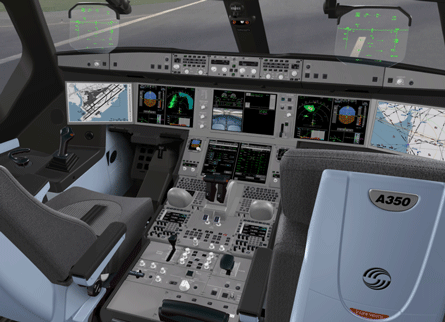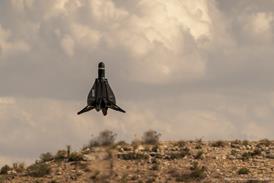Airbus says it is pursing an evolutionary, rather than revolutionary, approach to the design of the A350 XWB's flightdeck, despite the decision to adopt an all-new configuration with fewer, larger displays.
Last year, the A350's cockpit underwent a major rethink with the decision to move away from the A380-based layout to an all-new configuration that rivals the Boeing 787. The change saw the A380's 10-screen layout (including two on-board information system (OIS) displays) replaced by six much larger screens.
 |
|---|
© Airbus |
"We're not making quite the same step-change with the A350 that we did in going from the A340 to the A380," says Airbus test pilot Peter Chandler. "The large screens provide the potential in the future for new types of displays."
Chandler says that while the new flightdeck has "a lot of new technology and future proofing", the general philosophy has been to build on the A380 "and not go through a whole redesign for the second time in five years".
Thales has recently been selected over Honeywell and Rockwell-Collins to supply the six identical 15in (38cm) rectangular screens and the keyboard cursor control unit (KCCU) flight management system interface.
The XWB's flightdeck configuration has two central displays mounted one above the other (the lower one on the centre console in front of the thrust levers), and a single primary flight/navigation display in front of each pilot with an on-board information system screen adjacent to it.
"On the A380, the external displays are purely for the OIS, where as on the A350 they are integrated," says Chandler. "This allows us to display the OIS in the centre screen for briefings from a chart, for example. And in case of failure we can reconfigure using the external displays as well, which we can't do on the A380."
Chandler says that in format terms, the navigation and primary flight displays will change little from the A380, at least in the near term. He adds that commonality between the A380 and A350 will be high, with for example, the FMS interface being "virtually identical". This will incorporate the KCCU trackball and QWERTY keyboard on the pedestal.
"The advantage of having common screens allows us to use the KCCU to interface with the OIS. There will still be a keyboard in each pilot's table, but the KCCU is very well adapted for a much of what you do with OIS," says Chandler.
"For now the A350 KCCU definition has the A380's QWERTY keyboard [rather than the traditional 'ABCD' design that Boeing has adopted for the 787], but we've still got a couple of years to go before we finalise it."
Airbus is using a wooden mock-up with the correct dimensions to finalise the basic layout and check ergonomics. "At the moment a lot of the work is being carried out on the prototyping simulators or through modification of the A380 simulators," says Chandler.
Source: FlightGlobal.com























